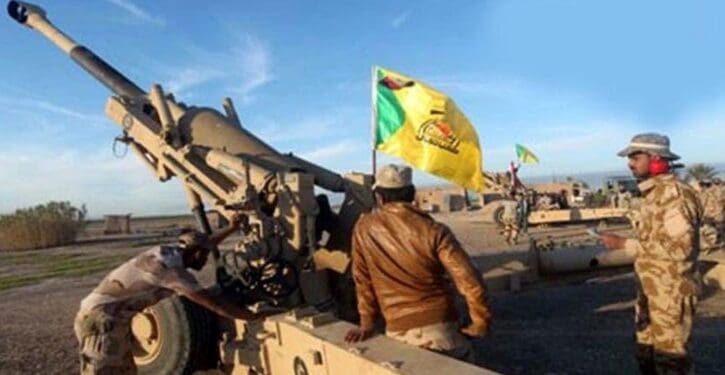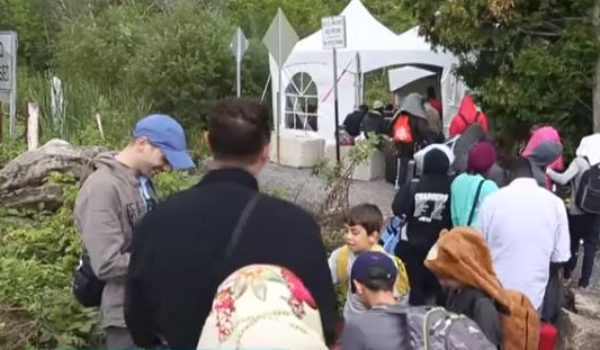
Americans were startled to learn on Saturday that Lebanon’s Prime Minister Saad al-Hariri had resigned abruptly – addressing his nation from a remote perch in Saudi Arabia – and within a short time, Iran-backed Houthis in Yemen had fired a ballistic missile at King Khalid International Airport near the Saudi capital of Riyadh.
The Saudis intercepted the incoming missile. They were also busy throughout the day on Saturday rounding up princes and arresting them, in order to consolidate power in the Kingdom.
Lebanon will be left with Hezbollah to decide what comes next there. Whatever the Saudis’ next move is, it won’t be brokering a follow-on coalition in Lebanon under the now-ended status quo. Riyadh has effectively checked out of that loop for the time being.
Will this presidential election be the most important in American history?
This isn’t some nutty Middle Eastern ritual going on. The reason it’s all happening now is that a sequence of events is unfolding: one that’s visible on a map, but that there is virtually no reporting on in the U.S.
The sequence of events, taken together, equals Iran completing her land bridge – her military line of communication – across Iraq and into Syria. This is a major shift, one that under the best of circumstances would be a permanently destabilizing, if latent, condition.
But the best of circumstances are not what we face. The U.S. is out of position to contain this situation. No one else can contain it. It will metastasize; the only questions are how, and how fast.

I have been arguing for months that we should engage the erstwhile U.S.-led coalition in Iraq and Syria to block this move. (See here for the proposed strategy, laid out.) But we never made the feeblest attempt to do that, and now Iran is completing the move. It’s a done deal at this point. Forces backed by Iran are within a few dozen miles of each other in eastern Syria now, and will be able to hook up in the next few days.
The pretext for Iran, as always (since 2014), is “defeating ISIS.” Iran has exploited this strategic pretext throughout her campaign across Iraq, and the companion drive with Assad into eastern Syria, to gobble up the territory that will form her land bridge.
Her move against the Kurds in northern Iraq a few weeks ago makes the land bridge more secure, relieving the pressure on Iran from Kurdish military capabilities in northern Iraq, and positioning Iran to hold a veto over the territory where Turkey will also want to gain leverage.

Iran’s earlier moves toward completing this genuinely epic strategic goal were behind the Saudis’ decision in early June to cut ties with Qatar. Qatar, a key member of the U.S. coalition, has been too cozy with Iran for some time now – as the Saudis see it – and is actively working to foster policies that Iran favors, and that are disadvantageous to the Saudis’ and other Sunni Arabs’ (Egypt, Jordan, the Gulf states) political vision for the region.
It became clear in the last six weeks that the U.S. was going to do nothing to stop Iran’s progress across either Iraq or Syria. What was not so clear, until this weekend, was that the Iran-backed move to complete the land bridge could be accomplished as quickly as it has been. The final campaign has taken only about eight days so far, and the link-up of the pincer Iran has closing in is imminent.
In brief, Assad and the Iran-backed militias on the Syria side have fully taken the key city of Deir ez-Zor, and are now moving southeast from it toward the border town of al-Bukamal. They are also headed east along the border toward al-Bukamal (see map).
[Note on the tweet with Qods Force commander Qassem Soleimani in it: it is being sent around Twitter with the indication that it is a recent image of Soleimani in Deir ez-Zor, in connection with the complete takeover of the city from ISIS by Iran-backed and Syrian regime forces. The images, which were first posted early on 4 Nov, from what I can tell, are indeed new ones, not previously circulated. They may be a day to several days old. I am still trying to confirm that they were taken in Deir ez-Zor. With those caveats in mind, enjoy.]
https://twitter.com/AdamNN/status/926953529629184000

On the Iraqi side, where I suggested in the summer that we should encourage Iraqi National forces to move in on ISIS, Iran has now gotten that process underway. There is no question at this point of Iraqi forces serving as an independent guarantor of Anbar. They are “liberating” Anbar from ISIS using Iran-backed militias – the Hashd al-Shaabi (PMU) – alongside the Iraqi Army. This is being done to benefit Iran.
Iraq is Free from Daesh Terrorists.. Hashd secure #AlQaim #Anbar pic.twitter.com/Iso6VAloZe
— iQ MidEast Centre (@iQMidEastCentre) November 3, 2017
Pic of #Iraq|i forces and members of Hashed al-Shaabi forces advance towards the city of al-#Qaim #Anabr pic.twitter.com/UAOsKWsppD
— Middle East Update (@islamicworldupd) November 4, 2017
200 hours was enough for Hashd & Iraqi Army to secure the ‘last Daesh stronghold’ in #AlQaim#Qaim #Anbar #Iraq pic.twitter.com/EZ1Eg4eNKb
— محمد كاظم خضير (@mhmmed_kadim) November 4, 2017
The famous ‘Jeddo’ (Grandad) of Hashd was on the frontlines of #AlQaim operation #Iraq pic.twitter.com/scwHZWLSDa
— محمد كاظم خضير (@mhmmed_kadim) November 4, 2017
Iraqi forces liberate #AlQaim swiftly in record time!
Army 9th Armoured Div
Hashd 26th and 46th Brigades
Hashd Armoured Division#Anbar pic.twitter.com/sHHYd8rfcR— محمد كاظم خضير (@mhmmed_kadim) November 4, 2017
See the Hashd commanders Hadi al-Ameri and Abu Mahdi al-Muhandis, both long connected to Soleimani, the Qods Force, and Hezbollah, present and participating in the current campaign at al-Qaim.
ISF source: Close coordination of Hashd and ISF was key for swift success in #AlQaim #Oraq pic.twitter.com/L2QFgWAz6m
— محمد كاظم خضير (@mhmmed_kadim) November 4, 2017
https://twitter.com/EnglishAlwaght/status/927043641801101313
The Iraqi border crossing at Al-Qaim was taken in fighting on Friday and Saturday. Shortly afterward, PMU troops reportedly entered Syria, and less than 24 hours ago were in a firefight with ISIS about 3 km south of al-Bukamal.


That puts the Iran-backed forces coming from the three directions toward al-Bukamal within 45 miles of each other. In the direction they are heading, their only obstacle is a few remnants of ISIS, scattered and mostly unable to put up much of a fight.
This imminent hook-up is why the Saudis are changing their posture as we speak. It’s also why Benjamin Netanyahu has been so vocal in recent weeks about Israel’s “red lines” in Syria, and what Israeli security cannot tolerate.
If Iran can use this corridor for maneuvers with a military purpose – and Iran will be able to; Iraq is incapable of preventing it – then nothing in the Middle East can remain as it is. (Next two maps are from my post a few weeks ago (link above) outlining how Iran’s influence in Iraq is tipping to military dominance.)


The only surprise about this is how quickly it is being accomplished. The change is already happening. There is no option of preventing it. Iran will have her land bridge: a military line of communication to the Levant and the Mediterranean that she hasn’t had, in any political guise, “Persian” or “Iranian,” since before the conquests of Alexander the Great.
If you think revolutionary Iran wants this land bridge in order to sit quietly and wait at one end of it, you haven’t been paying attention for the last 38 years.
(Remember, it was 38 years ago to the day, on Saturday, when the U.S. embassy in Tehran was overrun by “student” revolutionaries during the Iranian revolution. 4 November 1979.)
Geography hasn’t changed in the last 2,300 years. But the character of today’s Iran is a modern, radical-Islamic phenomenon. It marries the inevitable, perennial calculations about natural resources and topography with a radical, apocalyptic ideology, and the information-age vision and technology of warfare and geopolitics.
And Iran has no reason to anticipate that this extremely disruptive move on her part will be followed by a period of stability. The mullahs will want to move quickly toward their goal. That, we can recognize, even if the exact outlines of the strategy are not clear yet.
Iran knows she cannot simply marshal forces and attack Israel, for example. Not at the moment. But that is what the mullahs have in mind, along with a vision for a Shia caliphate to which the rest of the West will be subjugated. The question is not whether the revolutionary leadership will pursue that goal, but exactly how.
There will be much to sort out in the coming days. Three additional factors should both give us pause, and shape our thinking.
The first one is this: the U.S., for whatever reason(s), is essentially a neutralized quantity in this emerging problem. In the interest of keeping this short, I won’t even spend time analyzing why that is. We have been neutralized in relation to this dynamic – Iran moving across Iraq – since 2011. It didn’t start with Trump, but it hasn’t ended with him either.
Here is a token of just how neutralized we are. If you think we may be over there protesting ineffectively against Iran’s move to complete her land bridge, think again. Far from protesting, we are congratulating Iraq and the Iranian-backed militias on their successful action.
https://twitter.com/Iron6_1AD/status/926537905899737088
We join #Iraq PM Al-Abadi in congratulating Iraqi Security Forces for clearing #ISIS from Al-Qaim & liberating the city in remarkable time! pic.twitter.com/QnPGywa3Ur
— OIR Spokesperson (@OIRSpox) November 3, 2017
In effect, we’re cheering them on for securing Iran’s land bridge for her.
The second factor is the involvement of Russia. Russia is all over this campaign in a supporting role. Russian forces have launched cruise missiles (from submarines) at targets south of Deir ez-Zor in the last 48 hours, and have mounted air strikes with Tu-22M3 Backfire bombers, near al-Qaim and al-Bukamal, every day since 1 November.
(Note: the original report on this was updated between 4 and 5 November to remove the references to Backfire bomber attacks and sub-launched cruise missile strikes. However, the Backfire bombers have been reported separately on Twitter. I include them both here, with a screen capture of the archive of the original report. If the archived version is scrubbed, the screen cap shows that the reference was in it originally.)

In other words, Russia’s direct support hasn’t been confined to the fight for Deir ez-Zor. Back in 2016 when Russia bombed U.S.-backed rebel forces operating in at-Tanf, further west along the Syria-Iraq border, I pointed out that Russia’s interest was tellingly clarified by that action. Russia was willing to intervene in an area that wasn’t even meaningful to Assad at the time – an area that was only meaningful to Iran’s long-term project of securing her land bridge.
Now the robust Russian participation in the Qaim-Bukamal link-up clarifies the same thing. Russia regards this as an interest of hers.
The third factor is Netanyahu’s repeated representations that Israel can’t sit still for this. I wrote once before that it would be wise, if you haven’t consulted a map in a while, to look at one, and think about what Israel may have to do to keep her territory defensible, if Iran can move men and weaponry so much closer to it without resistance. All I will say tonight is that what Israel may have to do will not be confined to bombing weapons depots in Syria.




